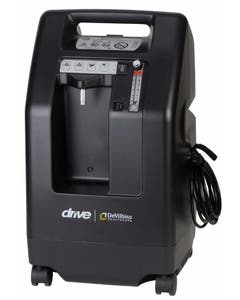

Patients with respiratory illnesses may sometimes require the highest level of oxygen purity. A medical grade oxygen concentrator provides that elevated purity level at all flow settings. To understand purity levels, we must first understand how an oxygen concentrator is designed.
An oxygen concentrator is made up of several key parts that convert ambient air into pure oxygen.
- The compressor extracts the ambient air from the surroundings.
- The sieve bed contains the mineral Zeolite which absorbs nitrogen from the extracted air.
- A reservoir contains the pure oxygen to be channeled through a tube into the nasal cannula or mask of the patient.
How Does a Medical Grade Oxygen Concentrator Work?
A medical grade oxygen concentrator functions much the same as other oxygen concentrators. The difference is in the use of additional sieve beds to filter more nitrogen from the extracted air, resulting in oxygen with a higher purity level.
Medical grade oxygen concentrators will be prescribed by doctors for respiratory illnesses. Conventional oxygen concentrators are useful for therapeutic purposes but not for managing medical conditions.
Oxygen tanks are also an option for patients; however, they require frequent replenishment and may require storing highly flammable high-pressure tanks at home.
Patients may also consider liquid oxygen systems. Liquid oxygen is frozen and compressed and requires refilling a portable unit from a stationary unit. Liquid oxygen provides higher purity flow compared to conventional oxygen concentrators but can be an injury risk for some patients as it is very cold to the touch.
Features of Oxygen Concentrator Medical Grade
If you are prescribed an oxygen concentrator medical grade it is important to know many of the features of this type of oxygen therapy.
Purity Levels
Medical grade oxygen concentrators maintain a 90-95% purity level at all flow rates. Because purity level is important for certain respiratory conditions, be sure to check the purity level of your concentrator before purchase.
Flow Rates
Most oxygen concentrators have a flow rate between 5-10 liters of oxygen per minute. Your doctor will recommend a flow rate. Be sure the medical grade oxygen concentrator you choose can provide the recommended flow rate.
Safety Features
Most oxygen concentrators have a flow rate between 5-10 liters of oxygen per minute. Your doctor will recommend a flow rate. Be sure the medical grade oxygen concentrator you choose can provide the recommended flow rate.
Benefits of Using Medical Grade Oxygen Concentrators


A medical grade oxygen concentrator can become an essential part of managing any respiratory illness. Better breathing through oxygen therapy improves quality of life including better sleep and the ability to engage in more physical activities.
Portable oxygen concentrators have made it easy for patients to leave home and have more freedom without worries about their respiratory condition. Rechargeable and long-lasting batteries have made portable oxygen therapy more accessible to patients traveling abroad, taking road trips and camping.
While there are other oxygen therapy options, oxygen concentrators tend to be the most cost-effective. Because they create oxygen from ambient air, there are no oxygen tanks to replenish, and the well-being risks are lower compared to liquid oxygen systems.
Difference Between Medical Grade vs. Commercial Grade
In your search for an oxygen concentrator, you may find commercial grade and medical grade options. It’s important to know the difference based on your personal needs.
Oxygen Purity Levels
The purity of medical grade oxygen concentrators are very specific—between 90-95%. If this is recommended by your doctor, then a commercial grade oxygen concentrator may not meet your medical needs.
Regulatory Standards and Certifications
Medical grade oxygen concentrators meet the strict medical regulatory standards of pure oxygen output. Commercial grade oxygen concentrators are not required to meet these standards.
Intended Use and Application
Your doctor prescribed a medical grade oxygen concentrator for a reason: your respiratory condition requires it. Commercial grade oxygen concentrators are more commonly used for well-being purposes, from boosting respiration for athletic performance to helping rejuvenate yourself with a fresh burst of oxygen after a long day. Commercial grade oxygen concentrators are not for medical use.
What Is the Optimum Purity of Medical Grade Oxygen Concentrator?
The purity standards of medical grade oxygen concentrators are what sets them apart from other types of oxygen concentrators. The range of 90-95% oxygen purity is considered optimal. Medical grade concentrators often aim for a minimum of 90% purity at all flow rates, so purity levels do not change with flow settings. Many high-end medical grade oxygen concentrators can provide up to 96% purity.
Maintenance and Care of Oxygen Concentrator Medical Grade
The regular maintenance of a medical-grade oxygen concentrator is easy. Most oxygen concentrators have a filter that needs to be cleaned regularly. You should also clean the outside of the unit with a damp cloth. Masks and hoses need to be washed with warm, soapy water to prevent bacteria growth. Nasal cannulas need to be changed weekly. Most manufacturer guidelines explain all maintenance needs.
If you experience low oxygen levels, check to make sure the filter is clean. Also, make sure your oxygen concentrator’s vents are not blocked. Look for kinks in your hose. Many issues of oxygen flow are usually simple fixes. Find more troubleshooting tips here.
Choosing the Right Medical Grade Oxygen Concentrator
When it comes time to purchase your medical grade oxygen concentrator take these factors into consideration:
Prescription requirements: Make sure your unit matches the recommendations from your doctor. This can include flow settings, (pulse flow or continuous flow) and LPM (liters per minute).
Lifestyle: Are you active? A portable oxygen concentrator vs. a stationary oxygen concentrator may be a better fit for your daily life activities.
Dimensions: If you are choosing a stationary home oxygen concentrator, then you may look for a model that is not too bulky or heavy so it can be easily moved around your home. If you go with a portable unit, you may want one that is smaller and lightweight, so it is easier to carry.
Explore some popular medical grade oxygen concentrators:







